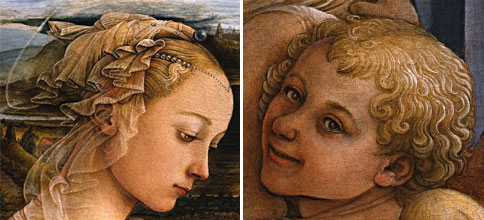Madonna with Child and two Angels by Filippo Lippi

This work by Filippo Lippi, painted around 1465, is one of his best known and most admired paintings of the Renaissance.
The life of Filippo Lippi, a Carmelite monk, makes an interesting tale. The monk was not exactly devoted to his religious duties and fell in love with a nun, Lucrezia Buti. His love was returned by the nun Lucrezia and, after years of a passionate “secretive” affair, they both were forced to renounce their religious votes. They had two children, a daughter and a son, Filippino, who would later become a a brilliant painter following in the steps of his father.
The popularity of this work of art likely comes from the fact that many think the semblance of the Madonna may actually be the portrait of Lucrezia Buti.
The Virgin Mary is depicted in profile, praying in front of the Child supported by two angels whose faces actually make them look like two rascals or young boys. Behind them is a beautiful landscape inspired by Flemish paintings. The Virgin’s hairstyle is very elegant and embellished with pearls and veils.
The sweetness of the composition, as well as the gracefulness of the veils and the woman’s hairdressing would later become a model of elegance for many painters, such as Botticelli. In fact, the author of “The Birth of Venus” and the “Spring”, was not only a pupil of Filippo Lippi’s, but also a close friend and co-worker of the master’s son, Filippino.
You will find the Madonna with Child and two Angels by Filippo Lippi in Hall #8 dedicated to Filippo Lippi.

Detail of the Madonna’s hair dressing and beautiful face; the angel that seems to watch the viewer of the painting









